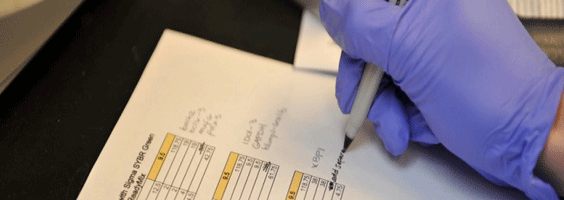LCGC is proactively seeking partnerships with pharmaceutical companies,
research foundations, and academic centers of excellence
We connect academia's discovery research talent with pharma's development capability
A top-tier pharmaceutical company and thirteen academic institutions have joined the Double-Blinded Drug Discovery® Consortium within one year of its inception.
LIMR Chemical Genomics Center's (LCGC) business model forges a protected open-innovation framework called Double-Blinded Drug Discovery (DBD2)®, establishing a totally new public-private partnering consortium. Our patented NanoTube Automated Repository System (NARS) supports operations by storing and rapidly retrieving up to 10 million samples using a robot working in a room-size freezer on our campus. We provide pharma's vast medicinal libraries formatted in a way that speeds new leads discovery by 500%. As an agent for this new public-private partnering approach, LCGC is:
-
Continually adding compound libraries to our current (250K) collection, unavailable elsewhere
-
Providing services at low or no cost in exchange for milestone-gated downstream compensation
-
Measurably accelerating translation research to validate novel targets as druggable
-
Enhancing HTS efficiency by 5-fold to conserve costs and speed the detection of the best leads
-
Specialized research program for detecting serendipitous drug synergy
-
Kick-starting 'instant collaboration' between leading scientists in academia and industry
-
Elevating success rates in pharmaceutical R&D with robustly validated methodologies
Our DBD2 mission is to serve as a transformative 'agent' for expanding pharma's external innovation network by bringing truly enabling resources to Principal investigators - working in a highly parallel, university ecosystem of chemical biology research worldwide - who aim to illuminate cell signaling interactions that govern disease. This is essential to find new cures that pharma can develop and commercialize with greater success more cost-effectively.
To learn more about partnering with LCGC please email us at info@csbiochina.com
University Partnering
LCGC is an authorized provider of pharmaceutical company libraries,
made available to university researchers
LCGC supports collaborations while protecting all intellectual property.
High throughput screening (HTS) is an important translational research tool for scientists in academia. A common pitfall is that tractable drug leads are unlikely to arise from HTS on commercial compound libraries used by universities. Those common libraries are not richly annotated with decades of validated biodata, nor do they include thousands of novel, repurposable chemical scaffolds from terminated drug development programs owned only by pharmas.
Achieve high-impact recognition for the medicinal utility of your translational research. Assay-ready plates pre-arrayed with pharmas best compound libraries are delivered to your lab or the HTS core for ultra-efficient new leads discovery. DBD2 for universities immediately connects your target translation research with productive drug development resources to advance medicinal discovery.
-
Only a simple reagent-adder and reader are required for most HTS assays
-
Special library formatting increases HTS efficiency by 500%
-
Emphasis fields include: CNS and Neurodegeneration, Metabolic Disease, Cardiovascular, Renal, Cancer, Immune and Viral/Infectious Diseases
-
IP secure. Transparent. Maintains publication rights. Zero cost.
To learn more about partnering with pharmas via LCGC, please email us at info@csbiochina.com.
Industry Partnering
LCGC manages proprietary chemical collections in a new way
to explore target biology-space with minimal investment and low risk
Execution of a single collaborative agreement provides access to chemical-biology research networks at universities worldwide.
The DBD2 model is a paradigm-shifting opportunity for pharmas providing a true missing link to transform pharmaceutical R&D. The approach is designed to for therapeutic area (TA) teams to de-risk highly innovative targets that are under active investigation by the best scientific talent in the hugely parallel, chemical-biology ecosystem in academia worldwide. The rationale is that strategic exposure of a representative snapshot-collection of the Company's under-utilized chemical assets is a solution to the challenge of advancing pharmaceutical innovation to deliver unmet patient need during a period of extraordinary organizational transitions and cost-cutting in pharma R&D.
Deliverables
-
Measurably increase productive collaborations in target biology, leads discovery and candidate characterization for deeper insight on mechanisms of action
-
Unveil latent medicinal candidates for novel targets and signaling pathways that are not under active investigation by TAs
-
Repurpose terminated candidates known to be bio-available and safe
The DBD2 Term Sheet is available for review on request. To learn more about partnering with LCGC please contact info@csbiochina.com

Results
Results from our commercial clients and academic collaborators clearly validate LCGC's data mining
algorithms. OPS-HTS is a powerful formatting technology when applied knowledgably and appropriately
for a wide variety of assay formats and readouts. Many working with us have obtained potent and
efficacious leads from the LCGC library and OPS. Confirmation retests following pooled HTS consistently
yield results as good as, or better than, n = 1 screening (as supported by detailed data from two
peer-reviewed published studies). In biochemical assays, the average hit confirmation rate we observed
was 74% and in cellular assays this was 89%.
|
 沪公网安备 31011502005552号
沪ICP备13005633号-1
沪公网安备 31011502005552号
沪ICP备13005633号-1